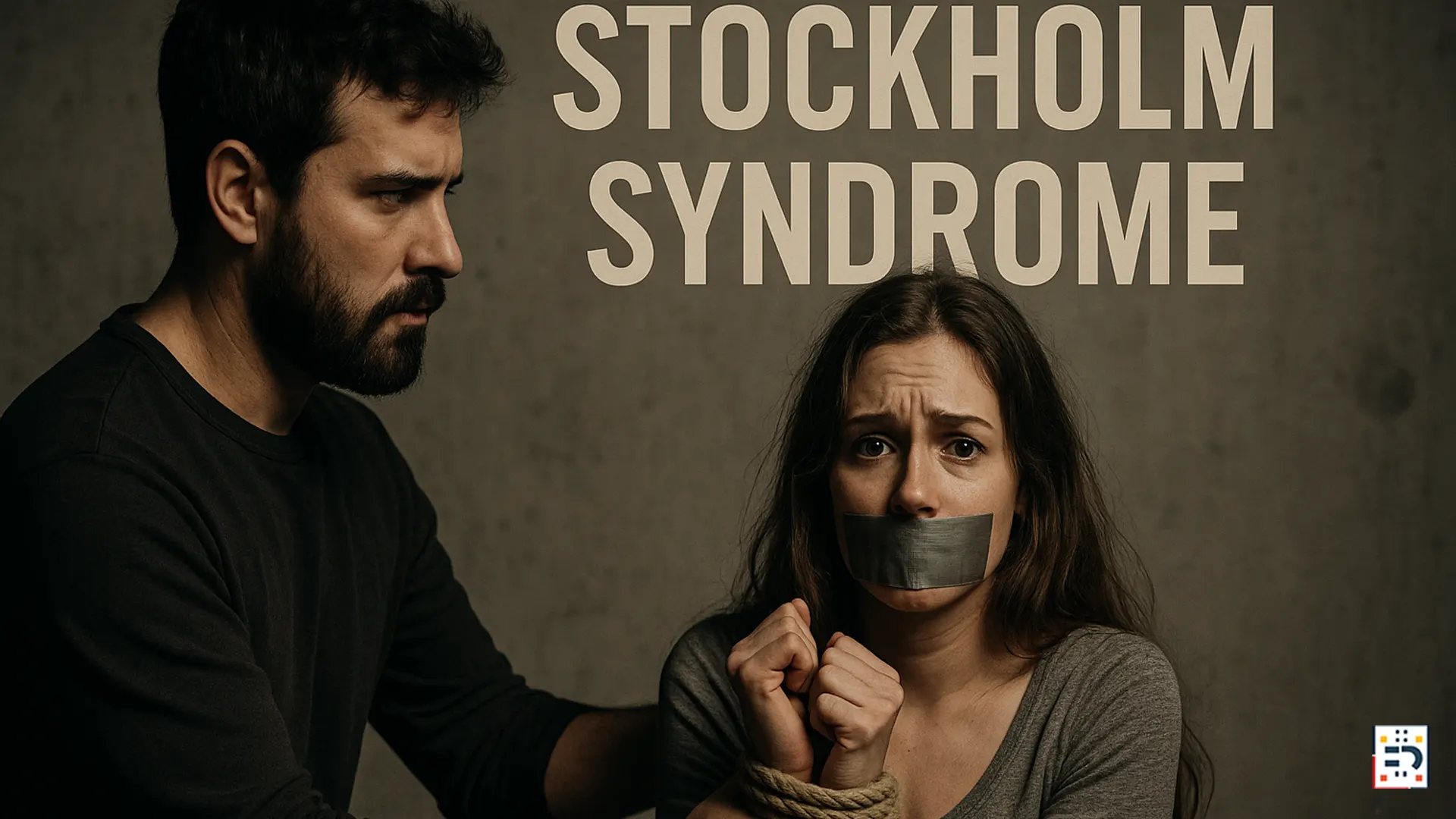Introduction to Stockholm Syndrome
Stockholm Syndrome refers to a remarkable but troubling psychological phenomenon where victims develop emotional bonds with those who control or harm them. It challenges our understanding of trauma, loyalty, and survival.
In 2025, the term gained renewed attention when Kim Kardashian publicly admitted that during her relationship with Kanye West she “felt like I had a little bit of Stockholm Syndrome.” Her statement offers deep insight into how trauma-bonding and emotional captivity can manifest even outside physical confinement.
Definition and Origin of the Term
The phrase “Stockholm Syndrome” originated from a 1973 Swedish bank robbery in Norrmalmstorg, where hostages began sympathizing with their captors. Criminologist Nils Bejerot coined the term after witnessing the paradoxical affection between captives and criminals.
This event demonstrated that human empathy and survival instincts can blur moral boundaries—a phenomenon later supported by psychologists and trauma researchers.

Psychological Foundations of Stockholm Syndrome
Emotional Bonding Under Duress
When individuals experience powerlessness or fear, even small kindnesses from captors are perceived as life-saving. This gratitude can evolve into emotional bonding.
Experts at Medical News Today note that trauma bonding arises in cycles of fear and relief, reinforcing attachment through inconsistent rewards and punishments.
Role of Power Imbalance and Fear
The dynamic depends on power inequality—one person exerts control while the other’s autonomy is stripped away. Aligning with the dominant figure becomes a strategy for safety and psychological balance.
The Survival Mechanism Behind the Bond
Psychological studies indicate that such attachments can serve as protective mechanisms. The brain prioritizes survival over logical reasoning, creating empathy where none would seem to belong.
Symptoms and Behavioural Patterns
Cognitive Dissonance and Emotional Dependence
Victims often know they’re being harmed yet feel compelled to defend the abuser. WebMD identifies key symptoms: affection toward captors, distrust of authorities, and justification of abuse.
The Illusion of Empathy Toward Captors
Victims may interpret controlling behaviours as protective or caring. This emotional misalignment deepens dependency, complicating rescue or recovery efforts.
Long-Term Psychological Effects
After the trauma, survivors may suffer PTSD, anxiety, or guilt. Rebuilding self-trust requires therapy and time to re-establish emotional independence.
Real-World Examples of Stockholm Syndrome
The Patty Hearst Case
In 1974, American heiress Patty Hearst was kidnapped by the Symbionese Liberation Army and later participated in their crimes. Psychologists cited her as a textbook case of Stockholm Syndrome in the media.
Elizabeth Smart and Other Modern Examples
Kidnapping survivor Elizabeth Smart reported a confusing emotional attachment to her captor—a result of fear, manipulation, and dependence for survival.
Kim Kardashian’s 2025 Revelation
In a 2025 interview on The Kardashians, Kim Kardashian said:
“I always felt like I had a little bit of Stockholm syndrome … I always felt really bad and always protected him and always wanted to help him.”
Her confession mirrors classic trauma-bonding dynamics described in psychology: emotional loyalty, guilt, and responsibility toward a controlling partner.
As covered in InStyle, she felt she had to “protect” Kanye despite public controversies—a pattern reflecting emotional captivity rather than romantic devotion.

Diagnosing Stockholm Syndrome: Challenges and Controversies
Lack of Official DSM Classification
The American Psychiatric Association does not list Stockholm Syndrome as a formal diagnosis, treating it instead as a subcategory of trauma responses such as complex PTSD or trauma bonding.
Debate Among Psychologists and Sociologists
Some experts praise the term’s usefulness in understanding victims’ behaviour, while others caution it oversimplifies. Articles on Breakthrough Trauma Therapy explore how “Stockholm Syndrome” and “trauma bonding” overlap and differ.
Stockholm Syndrome Beyond Hostage Situations
In Abusive Relationships and Domestic Violence
Emotional attachment to abusers is common among domestic violence survivors. Like Kim Kardashian, they may feel guilt, protectiveness, or empathy for the person causing harm—a bond forged through trauma and fear.
In Workplaces and Cult Environments
Authoritarian workplaces and cults often replicate the same dynamics: control, fear, isolation, and intermittent rewards that maintain loyalty.
Treatment and Recovery Strategies
Therapy and Trauma Counseling
Treatment involves trauma-informed therapy, including CBT and EMDR. These help survivors identify distorted loyalty patterns and regain self-agency.
Rebuilding Trust and Identity
Recovery means redefining the self outside trauma. This includes setting emotional boundaries, forming healthy relationships, and recognizing that the attachment was a survival strategy, not love.
Preventive Measures and Public Awareness
Role of Law Enforcement and Crisis Negotiation
Modern hostage negotiators are trained to anticipate emotional bonding during captivity, ensuring victims are treated with empathy after rescue.
Educational Campaigns and Mental Health Advocacy
Public education and campaigns by trauma organizations emphasize that loyalty to abusers stems from psychological survival, not weakness. Awareness reduces stigma and encourages survivors to seek help early.

Cultural Impact of Stockholm Syndrome
In Movies, Literature, and Pop Culture
Films such as Beauty and the Beast and shows like Money Heist often portray this theme—romanticizing trauma bonds as affection. Psychologists warn that these portrayals distort the true survival-based nature of Stockholm Syndrome.
The Misuse of the Term in Media Narratives
Media outlets sometimes misuse the phrase to describe any intense loyalty. Kim Kardashian’s candid use of the term has re-centred the conversation on its clinical and emotional reality, helping audiences understand it’s about trauma, not devotion.
Frequently Asked Questions (FAQs)
1. What causes Stockholm Syndrome?
It develops from power imbalance, threat, and dependency on the abuser, combined with intermittent kindness that triggers emotional confusion.
2. Is Stockholm Syndrome officially recognised?
No—it’s not in the DSM-5, but mental-health professionals treat it within trauma response frameworks.
3. Can it occur in normal relationships?
Yes, especially in manipulative or abusive relationships that mirror hostage dynamics psychologically.
4. How does Kim Kardashian’s case relate?
Her admission has sparked public discussion on emotional captivity in high-profile relationships, reinforcing that psychological bonds to controlling partners can happen to anyone.
5. How is it treated?
Through trauma-focused therapy, emotional education, and strong social support systems.
6. Can someone fully recover?
Yes—by addressing trauma, rebuilding identity, and learning healthy attachment patterns, survivors can thrive beyond the trauma bond.
Understanding the Paradox of Compassion in Captivity
Stockholm Syndrome is a paradox of empathy born from fear—a testament to the mind’s adaptability under threat. From the 1973 Swedish bank robbery to Kim Kardashian’s 2025 revelation, the phenomenon continues to intrigue psychologists and the public alike.
Understanding it requires compassion, not judgment. Survivors aren’t weak—they’re human beings whose survival instincts rewired emotional perception. With awareness, therapy, and education, recovery is not only possible—it’s powerful.
#StockholmSyndrome #KimKardashian #TraumaBonding #PsychologyToday #EmotionalAbuse #MentalHealthAwareness #TraumaRecovery #AbuseSurvivor #RelationshipTrauma #HumanPsychology


